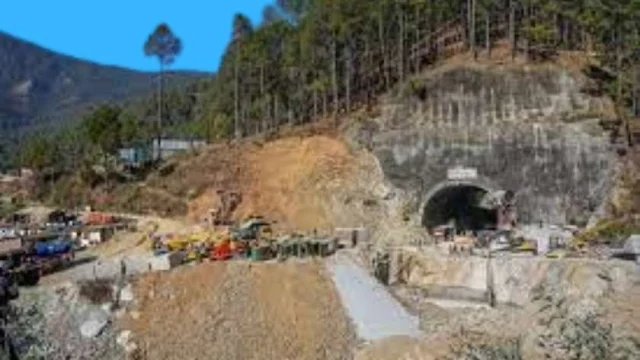41 stranded workers are rescued from the Uttarakhand tunnel catastrophe by rescue worker
 |
| 41 stranded workers are rescued from the Uttarakhand tunnel catastrophe by rescue workers |
Forty-one workmen who had been stranded in a collapsed Himalayan tunnel for 17 days have been released by rescuers in India.
In Uttarakhand, miners hand-drilled the last portion of the 4.5 km (3 km) tunnel so that workers could access it.
The patients were conveyed to the hospital for assessment on wheeled stretchers, which were passed via a 90 cm (3 ft) diameter conduit. Nobody was hurt.
Numerous obstacles stood in the way of the prolonged attempts to extract them from the collapsed Silkyara tunnel on November 12.
Thanks to the efforts of a crew of "rat-hole" miners who broke apart the rock with hand-held drills, the job was ultimately completed on Tuesday night.
Draupadi Murmu, the president of India, expressed her relief and happiness at the people's release in a post on X, the previous Twitter platform. In addition, he commended the rescue operation, calling it a "testament to human endurance" in the face of difficulty.
The workmen were welcomed with flowers and garlands as soon as they emerged from the tunnel.
Outside the tunnel, neighbors, friends, and relatives gathered, broke crackers, and shared candies.
From the start of the rescue, those above ground could communicate with those below using walkie-talkies. A separate, thin conduit carried food, drink, and oxygen to the below-ground participants.
The 890 km long, $1.5 billion (£1.19 billion) centerpiece Char Dham project includes the Silkyara Tunnel. It connects important Hindu pilgrimage locations in the Himalayas with two-lane roadways.
Teams have attempted to clear away around 60 meters of rock and metal debris that lay between the individuals and the tunnel's entrance after a section collapsed in as a result of a landslide. Its goal was to provide the stranded workers a horizontal escape path that included a crawl-out conduit.
Loose earth impeded work and metal rods cutting through the rubble often hindered rescue operations. Unless the primary drilling equipment within the tunnel broke down entirely, workers would be out within a few hours, according to authorities' announcement last Friday.
When this occurred, twelve "rat-hole" miners were sent in to dig by hand in order to free the trapped workers. They were skilled in navigating through small tunnels and cleared the last few meters of rubble with hand-held digging equipment to get to the laborers, who were from some of the poorest areas in India.
What a "rat hole" mine is like to operate in
Following this, rescue personnel outfitted with stretchers, ropes, and ladders entered the tunnel, while 41 ambulances were positioned outside to take patients to a hospital around 30 kilometers distant.
In an effort to establish a different rescue path, rescue personnel had also begun vertical drilling from the summit of the mountain where the stranded individuals were located.
"There was joy inside the tunnel the moment we came out of the last part of the debris," one of the rescue personnel told the BBC.
"The folks who were confined began to cheer and applaud. The cops then instructed them to be calm and patient. They threatened to eliminate each of them one at a time.
In a statement, the Uttarakhand government said that "both science and God" were to blame for the success of the rescue.
The males, the majority of whom are in their 20s, are said to be in excellent health. "He's in excellent shape and is simply fine, just like you or me. His health is not a concern," a National Disaster Response Force (NDRF) representative said news agency ANI. He was, nonetheless, sent to a neighboring hospital for a check-up.
Millions of Indians prayed for the male rescue workers, and they were horrified to learn about the lengthy rescue effort.
When a medical endoscope camera was inserted down a conduit that had been bored into the rubble on November 21, the first pictures of persons who were trapped appeared. In the brilliance of the tunnel lights, around twelve persons were seen standing in a semicircle, with helmets and coats typical of construction workers.
Rapid building, particularly the Chardham project, has been attributed by locals and environmentalists to soil subsidence in the region, which they believe had a role in the tunnel collapse.
Over 600 million Indians rely on the Uttarakhand area, the source of the Ganga and its main tributaries, for food and water. There are several woods, glaciers, and springs across the area.
Significantly, this area affects India's climate because of its topsoil, which naturally absorbs and stores carbon dioxide to lessen the effects of greenhouse gas emissions.
The project includes proposed tunnels for railway and hydropower projects in addition to the two major road tunnels, the 400 m long Silkyara Tunnel and the shorter 400 m tunnel at Chamba.
In the past fifteen to twenty years, tunnel construction has increased, environmentalist Hemant Dhyani told the BBC. "These mountains are not designed for this kind of extensive infrastructure development.”

No comments:
Post a Comment